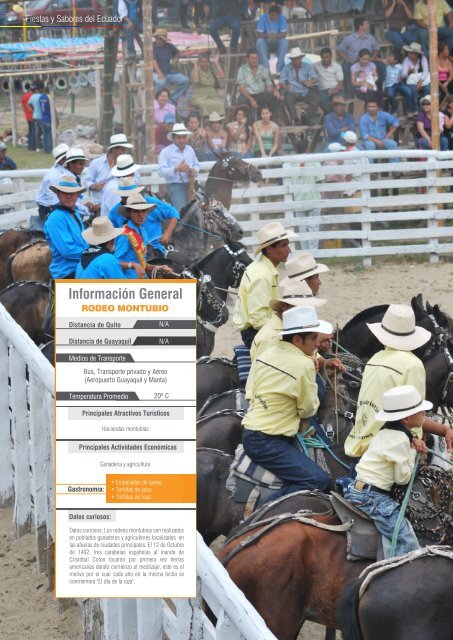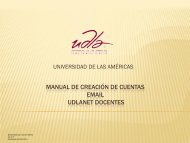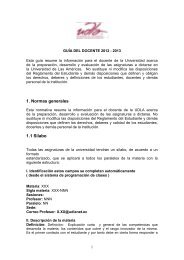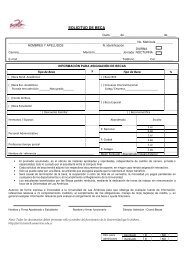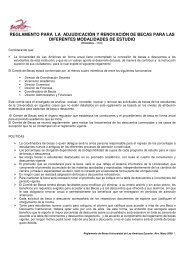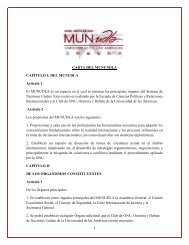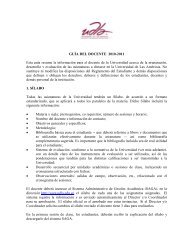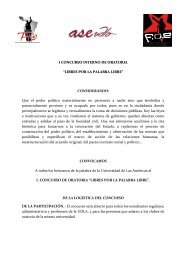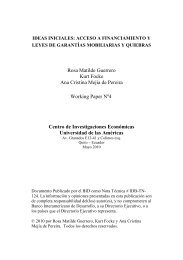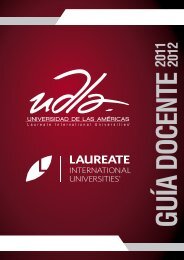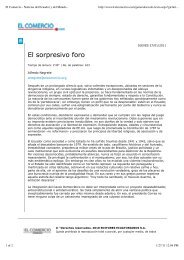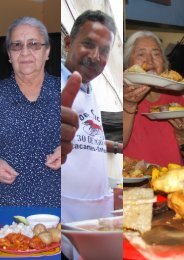Descarga Parte 6 - UDLA
Descarga Parte 6 - UDLA
Descarga Parte 6 - UDLA
Create successful ePaper yourself
Turn your PDF publications into a flip-book with our unique Google optimized e-Paper software.
Fiestas y Sabores del Ecuador<br />
230
La reina de la hacienda ganadera<br />
The queen of the farming hacienda<br />
Octubre • Rodeo Montubio<br />
es el momento en que el jurado calificador elige a “La Criolla<br />
Bonita”. A continuación se quedan solo las madrinas en el<br />
ruedo y, una por una, demuestran sus destrezas controlando<br />
su caballo: una mezcla de técnica, piruetas, diversión, es lo<br />
que se puede observar en cada uno de estas intervenciones.<br />
Aquella que haya logrado someter al animal, con el mejor estilo,<br />
es la ganadora del título “Señorita Rodeo”. Por supuesto,<br />
todos estos espectáculos están acompañados por música<br />
ranchera, que ambienta de manera perfecta los diferentes<br />
números. Después de la elegante participación de las mujeres,<br />
llega el turno de los hombres, que arranca con el “caracoleo”.<br />
El jinete más valiente, sin más ayuda que las espuelas<br />
de sus botas, domará y se mantendrá estable sobre un caballo<br />
salvaje, el cual estará simplemente ensillado y con riendas.<br />
Acto seguido los jinetes, formados paralelamente, realizan la<br />
destreza de lazo pial (donde, con los ojos vendados y el lazo<br />
en el pie, lograrán enlazar el cuello del corcel). Esta es una de<br />
las suertes más aplaudidas por el público, que en algunos<br />
momentos dispara al aire, con el fin de ponerle más calor al<br />
espectáculo.<br />
Como toda buena fiesta, esta lleva algo de humor. Tal es así<br />
que un grupo de payasitos salta al ruedo y logra someter a<br />
un novillo, tras una exhibición de cómicas destrezas. Es un<br />
momento ideal para las carcajadas, que relajan a los visitantes<br />
y encienden aún más la fiesta.<br />
Tras un largo día de festejos –y como todo buen pueblo-, los<br />
montubios culminan la celebración con un colorido baile. Al<br />
ritmo de bandas de pueblo y música tropical, danzan hasta<br />
el siguiente día, beben con deleite el auténtico aguardiente de<br />
caña y devoran las delicias culinarias del lugar, como empanadas<br />
de queso, caldo de gallina, tortillas de maíz y de<br />
yuca, y otros cuantos manjares más.<br />
Realmente estos rodeos se han convertido en la oportunidad<br />
perfecta para reunir vecinos y amigos, en una fiesta multicolor<br />
donde se celebra con enorme alegría el orgullo de ser<br />
campesino.<br />
231
Fiestas y Sabores del Ecuador<br />
232
Rodeo Montubio<br />
Date: 9th to 12th October Locaton: Manabí (Olmedo), Guayas (Balzar - Salitre - Daule - Colimes)<br />
Los Rios (Vinces - Palenque)<br />
Los payasos toreros<br />
Bullfighter clowns<br />
The Montubian towns and villages dress in joyous celebration<br />
on the month of October, and are celebrated<br />
through wild and unique rodeos.<br />
Being a Montubio implicates much more than just having to<br />
be born in the Ecuadorian coast. In fact, it is a combination of<br />
culture, history, and tradition that has existed for many years<br />
in these towns. The Montubios are authentic coastal countrymen,<br />
dedicated to agricultural and farming labors, dressed<br />
with much pride, in paja toquilla hats, scarfs, shirts and special<br />
pants, boots, and spurs.<br />
Day by day Montubios demonstrate the love and embrace they<br />
have for their racial roots.<br />
The first regional celebration of Montubian festivities started<br />
in 1926, in the Guayas Province. From then on, every year the<br />
Montubios honor their culture with celebrations filled of adventure,<br />
food, music, and dance.<br />
The rodeos Montubios that are mostly known are the ones from<br />
the towns of Balzar, Salitre, Daule, and Colimes in Guayas,<br />
Vinos and Palenque in Los Rios, and Olmedo in the Manabí<br />
province.<br />
On the 9th of October, Saturday we head out on an indescribable<br />
trip by Santo Domingo de los Tsáchilas, Junín, Chone,<br />
Canuto, and Portoviejo are coastal lands with incomparable<br />
natural views, which exhibit besides the banana treasure,<br />
mandarins, oranges, cacao, amongst many other wonderful<br />
treasures.<br />
Finally, we take a different way, which descends from the Ruta<br />
Del Café (Coffee Route) to a welcoming sign, saluting the tourists<br />
to Olmedo (Manabí) and inviting people to participate in<br />
the famous rodeo.<br />
Approximately 150 horsemen from different haciendas make<br />
their entrance to the town, around 2 o’clock in the afternoon.<br />
Many of them are visitors of other provinces, such as, Guayas<br />
or Los Ríos. Gradually the horsemen enter the “coso” (a structure<br />
of cañaguadua or wood), wherein the rodeo takes place.<br />
By then the stadiums are found to be practically packed with<br />
enthusiastic people and spiritual beer, awaiting anxiously for<br />
233
Fiestas y Sabores del Ecuador<br />
234
El “caracoleo”<br />
The “caracoleo”<br />
the event to commence.<br />
October • Rodeo Montubio<br />
In the hacienda, participants such as, “Santa Ana”, “Bolívar”,<br />
“San Ramón”, “San Marcos”, “Rosa Cristina”, “San Alejo”,<br />
“Auxiliadora” and “La Delicia” are present. Each and every<br />
one of these participants has a beautiful patroness or madrina,<br />
and 10 horsemen who are specialists in dominating wild<br />
horses. The spectacle makes way for the patroness parade,<br />
followed by their horsemen. This is the moment in which the<br />
scoring judge elects “La Criolla Bonita” or the beautiful Creole<br />
girl. The patronesses stay in the bull-ring, one by one, they<br />
demonstrate their talents in horse domination. It is a mixture of<br />
technique, pirouettes, entertainment; this can be witnessed in<br />
every rodeo event.<br />
The patroness that successfully dominates her horse, with the<br />
best rodeo style, is the winner of the title “Señorita Rodeo”.<br />
Of course, all of these spectacles are accompanied by country<br />
music, which brings a good touch to the environment, as<br />
well as different dances. After the elegant participation of the<br />
women, finally is the turn for the men to participate, the event<br />
is kicked off by the “caracoleo”.<br />
The bravest horseman rides a wild horse without any aid, only<br />
with the support of spurs on his boots. The horseman able to<br />
dominate and maintain stability on top of the wild horse, which<br />
only has a saddle and harness reins, is victorious. In the following<br />
act, horsemen form side to side, demonstrating their<br />
talent of lazo pial or roping (where horsemen are blindfolded<br />
and tie a rope on their foot, throwing the rope up and capturing<br />
the horse by the neck). This is one of the mostly acclaimed<br />
talents by the public, people show enthusiasm by firing up<br />
their guns, with the goal of heating up this amazing spectacle.<br />
As a good old feast, this brings a lot of humor. So much so,<br />
that a group of clowns jump to the bull-ring, in the attempt<br />
to dominate a novillo; young bull. They do so by simulating<br />
humorous talents. It is an ideal moment for laughter, relaxation<br />
for the visitors and fires up the festivities even more.<br />
Throughout a long day of celebration (and like a festive good<br />
old town) the Montubios culminate the celebration with a colorful<br />
dance. To the rhythm of musical town bands and tropical<br />
music, people dance till the following day, drinking with delight<br />
the authentic aguardiente, and devouring culinary delicacies of<br />
the location. Such as, cheese turnovers, hen soup, corn and<br />
yucca or cassava tortillas, and other delicacies.<br />
In fact, these rodeos have transformed into the perfect opportunity<br />
to unite neighbors and friends, in a multicolor festivity,<br />
celebrated with enormous happiness and the outmost pride of<br />
being a Montubio.<br />
235
Fiestas y Sabores del Ecuador<br />
236
Ingapalla<br />
Fecha: 3er Lunes de Octubre Lugar: Tisaleo - Tungurahua<br />
En el cantón Tisaleo,provincia de Tungurahua, ubicado en<br />
la Sierra Central del Ecuador, se desarrolla el segundo<br />
lunes de octubre la Fiesta de la Ingapalla y la celebración<br />
de la Virgen Patrona de la Vista, Santa Lucía. Esta celebración<br />
se remonta al siglo XVI, en que el cacique Tisaleo-con sus<br />
huestes-, frena y resiste el avance de los conquistadores españoles<br />
hacia la ciudad de Quito.La fiesta congrega a más de<br />
15 000 jinetes, que simbolizan diferentes hazañas militares de<br />
nuestros antiguos ejércitos frente a los conquistadores.<br />
En la celebración, llena de alegría y tradiciones,toda la tribu de<br />
los panzaleos espera a los conquistadores en la parte superior<br />
de la Avda. Principal o “Relleno de Tisaleo”, que es una<br />
pendiente. Esta tribu está formada por las pallas o princesas<br />
y por todos los indios de la comarca. Los panzaleos negocian<br />
el paso de los españoles de diferentes formas, ya sea<br />
con secuestros de los hijos pequeños de la tribu o el paso de<br />
sus mujeres. Mientras negociación viene y negociación va,<br />
comienza la batalla… Los jinetes conquistadores bajan de<br />
las Lomas de Pucará y arremeten simbólicamente contra los<br />
defensores del pueblo.<br />
Mientras se desenvuelve la batalla, unos 20 000 espectadores<br />
se acomodan en las faldas del “Relleno” para ver este suceso,<br />
bajo la presencia del volcán Carihuayrazo y del cerro Puñalica.<br />
Cada una de las veredas es inundada de su famoso “Pastel de<br />
Queso”, hecho con manteca,harina,leche y relleno de queso,<br />
La danza de las vírgenes del sol<br />
The dance of the sun virgins<br />
que compite en sabor con los turrones, la colada morada, las<br />
moras,frutillas, uvas y manzanas, todo ello matizado por el<br />
“puro” o licor de caña, que se ofrece y se convida a todos,<br />
mientras se cantan pasillos,albazos y danzantes. Esta fiesta<br />
está dividida en dos bandos: el primero, asumido por el Ejército<br />
del Capitán del Pueblo, quien representa al cacique Tisaleo.<br />
La segunda en el mando es la priosta, quien está rodeada<br />
de pallas o princesas. Detrás del cacique están los ingas,<br />
representados por niños,las tribus de Tisaleo y el Ejército de<br />
Rumiñahui. Son aproximadamente 200 personas en escena.<br />
El segundo bando está a cargo del Capitán de Caballería, máximo<br />
oficial del ejército español (Sebastián de Benalcázar). Está<br />
acompañado por la Priosta, que es la esposa del Capitán y<br />
lleva a los pajes, floreras, esclavas y ángeles. El ejército está<br />
compuesto por alférez, sargentos y chureros, y la tropa de<br />
caballería está escenificada por 300 jinetes.<br />
Esta fiesta es todo un ritual de batalla; está llena de bandas de<br />
guerra, martillos y música, que animan a los ejércitos a combatir.<br />
La fiesta constituye una gran atracción, en la que niños,<br />
jóvenes y adultos disfrutan de cada uno de sus detalles, y los<br />
combatientes añaden un toque de humor y picardía a las negociaciones<br />
previas a la batalla, la defensa del territorio y la protección<br />
a las princesas, ante el asedio de los conquistadores.<br />
Se trata de una fiesta realmente pintoresca, colorida y hermosa.<br />
237
Fiestas y Sabores del Ecuador<br />
238
Ingapalla<br />
Date: 3er Lunes de Octubre Location: Tisaleo - Tungurahua<br />
The district of Tisaleo, part of the Tungurahua province, is<br />
located in the Center of the Ecuadorian Sierra. The second<br />
Monday of October is when the festivities of Ingapalla<br />
and the celebration of the Virgen Patrona de la Vista, Santa<br />
Lucía initiate. This celebration originated in the 16th century,<br />
wherein the cacique Tisaleo, along with his armies restrained<br />
and placed a defense against the Spanish Conquistadors in the<br />
city of Quito. The feast congregates more than fifteen thousand<br />
cavalrymen, whom symbolize different military events of<br />
our ancient armies who fought against the Conquistadors.<br />
A celebration, filled with happiness and tradition, the entire tribe<br />
of the Panzaleos waits for the Conquistadors by the upper part<br />
of the Avenue. Main or “Relleno de Tisaleo”, that is located<br />
in the outskirts of Tisaleo down an inclined path. This tribe is<br />
formed by the palla or princesses and by all the natives of the<br />
region. Panzaleos attempted to negotiate the passage of the<br />
Spanish in different forms, however the Spanish moved in by<br />
force either through kidnappings of small children of the tribe,<br />
or tribal women. While negotiations went back and forth, the<br />
battle had already started… Conquistador cavalrymen came<br />
down from the hills of Pucará and symbolically fought against<br />
the defenders of the town.<br />
While, the battle develops twenty thousand spectators accommodate<br />
themselves by the skirts of “Relleno” in order to witness<br />
this event, under the presence of the Carihuayrazo volcano<br />
and the hill of Puñalica. Each and every sidewalk is flooded<br />
with the famous “Pastel de Queso;” cheese turnover, it is made<br />
with pork lard, flour, milk, and cheese filling. This competes<br />
No pasa nadie, se defienden los pueblos<br />
No one crosses, towns are defending one another<br />
with the flavor of turrones; sweets made with honey, la colada<br />
morada; the traditional Ecuadorian beverage, blackberries,<br />
strawberries, grapes, and apples all of which is blended with<br />
“pure” aguardiente, which is served to all, while singing and<br />
dancing pasillos and albazos. This festivities are led by two<br />
groups. The first is led by Army Captain of the town, who represents<br />
cacique Tisaleo. The second in control is the priosta;<br />
the feminine version of prioste, who is surrounded by pallasor<br />
princesses. Behind the cacique are the Ingas, represented by<br />
children. The tribes of Tisaleo and the Army of Rumiñahui are<br />
approximately represented by two hundred people.<br />
The second group is commanded by Cavalry Captain, who is<br />
highest in command of the Spanish Army (Sebastián de Benalcázar).<br />
He is accompanied by the priosta, who is the wife<br />
of the Captain; she takes characters such as, servants, comedians,<br />
slaves, and angels along. The Army is composed of officials,<br />
sergeants, and chureros, the cavalry troop is portrayed<br />
by three hundred cavalrymen.<br />
The celebration is a complete battle ritual. It is crowed with war<br />
bands, hammers, and music, cheering for the Armies to fight.<br />
The celebrations represent a great entertaining attraction, in<br />
which children, young adults, and adults enjoy each and every<br />
detail of the battles. The combatants add a touch of humor and<br />
cleverness to pre-battle negotiations, the defense of the territory<br />
and the protection of its princesses against the attack of<br />
the Conquistadors. In reality it is a colorful and beautiful feast<br />
with a picturesque representation of war battles.<br />
239
Fiestas y Sabores del Ecuador<br />
240
NOVIEMBRE<br />
NOVEMBER<br />
Finados<br />
Fiestas de Cuenca<br />
Mama Negra<br />
241
Fiestas y Sabores del Ecuador<br />
242
243
Fiestas y Sabores del Ecuador<br />
244
Finados<br />
Fecha: 2 de Noviembre Lugar: Todo el País<br />
“Al secarse la milpa del maíz,<br />
se conserva la mazorca; muere el tallo,<br />
pero queda la semilla…”<br />
A penas comienza el mes de noviembre y los cementerios de<br />
todo el país se llenan de color y sabor: miles de personas<br />
acuden a visitar a sus seres queridos y compartir un cálido<br />
momento con ellos, en su memoria.<br />
Para otras culturas, esto puede sonar algo descabellado,<br />
pero hay que tomar en cuenta que los grupos indígenas que<br />
habitaron el Ecuador hace mas de 5000 años -según su cosmovisión<br />
andina y la observación de los ciclos de la naturaleza-<br />
desarrollaron especialísimas creencias sobre la vida<br />
y la muerte. Para ellos, la existencia de una nueva vida en el<br />
mas allá era algo inobjetable.<br />
Reuniendo la familia para celebrar la fiesta<br />
Uniting the family in celebration of the feast<br />
Debido a estas creencias antiguas, que han perdurado de alguna<br />
manera en nuestros pueblos actuales,podemos encontrarnos<br />
cada 2 de noviembre con cementerios llenos de personas<br />
que decoran las tumbas de sus seres queridos; ponen<br />
velas para iluminar el camino de las almas en su nueva vida;<br />
agua para saciar la sed por el largo recorrido y fortalecer su<br />
regreso; sal como elemento de purificación, y flores como<br />
ofrenda de alegría y belleza, para realzar el ambiente festivo<br />
que emana de cada tumba. Y cómo no mencionar la comida,<br />
si parte importante de esta gran fiesta es el hecho de poder<br />
sentarse anualmente a comer con los seres queridos que ya<br />
no están presentes. Junto a las tumbas empieza el colorido<br />
festín: champús (bebida de maíz), cuy asado, chicha de jora,<br />
tortillas y panes de maíz, y la infaltable “achucuta”, que es<br />
una sopa elaborada con maíz, chochos, arveja, fréjol y carne<br />
de res.<br />
En Calderón, parroquia ubicada a solo 15 km al norte de Quito,<br />
comienza la mañana con una gran misa campal en el cementerio<br />
principal. La gente va llegando poco a poco, cargando<br />
fundas llenas de comida, ramos de flores de todos los colores<br />
imaginables, velas y cualquier objeto que pueda usarse como<br />
adorno. La mayoría pasa en el cementerio toda la mañana,<br />
hasta la hora de almuerzo en que, juntos y en familia, se sientan<br />
alrededor de una tumba para compartir los alimentos. Es<br />
un auténtico mosaico de colores y tradición: la gente, con sonrisas<br />
en los labios y casi sin ninguna melancolía, comparte<br />
momentos especiales con sus seres queridos, los que ya no<br />
están más en esta vida.<br />
Un ícono muy importante de estas celebraciones es la colada<br />
morada y las guaguas de pan. Toda cafetería, tienda, panadería<br />
de los diferentes barrios del país prepara y vende, con una semana<br />
de anticipación, estas delicias criollas. La colada morada es<br />
una bebida caliente, frutal y aromática, hecha a base de mora,<br />
mortiño y maíz morado. Se la acompaña de un delicioso pan,<br />
en forma de muñeca, decorado con cintas dulces de colores.<br />
El origen de estos alimentos es diverso: según algunas versiones,<br />
vienen de épocas incaicas; según otras, proceden de<br />
la conquista española. Sin importar cuál sea realmente la raíz<br />
de la colada morada y de las guaguas de pan, lo cierto es que<br />
en estas fechas todas las familias ecuatorianas se deleitan con<br />
estos excepcionales sabores.<br />
245
Fiestas y Sabores del Ecuador<br />
246
All Saints’ Day<br />
Date: November 2nd Location: All the Country<br />
“When the milpa of the corn dries,<br />
the cob is conserved;<br />
the stem dies, but the seed remains”<br />
As soon as November begins the cemeteries of the whole<br />
country are filled with color and flavor: thousands of<br />
people come to visit their loved ones and to share a<br />
warm moment that will last in their memories forever.<br />
For many cultures this can sound bizarre, however, it must be<br />
noted that native groups which used to reside in Ecuador over<br />
five thousand years ago developed special beliefs about life<br />
and death. According to, the Andean view of the universe and<br />
the observation of nature cycles, the principle in the existence<br />
of an afterlife for natives was unobjectionable.<br />
Due to these ancient beliefs, that have lingered in our<br />
La colada morada<br />
The colada morada<br />
townspeople, today every November 2nd we find cemeteries<br />
packed with people that decorate the graves of their loved<br />
ones; they place candles to illuminate the path for souls to<br />
find a new life; water to quench the thirst of the souls in their<br />
long journey and to strengthen their return; salt is used as an<br />
element of purification; and flowers as an offering of bliss and<br />
beauty, enhancing the festive environment that is emanated by<br />
every grave. How can the food not be mentioned, if a very<br />
important part of this feast is to sit every year and eat with<br />
the loved ones that have passed away… By the tombs the<br />
colorful festivity starts with champús; corn beverage, roasted<br />
guinea pig, chicha de Jora, corn bread and patties, and the<br />
unforgettable “achucuta”, a soup made with corn, lupini<br />
beans, peas, common beans, and beef.<br />
Calderon, a parish located 15 km away from northern Quito,<br />
celebrates this festivity in the morning with a great outdoor<br />
mass in the principal cemetery. People arrive little by little,<br />
carrying bags filled with food; flower bunches of all imaginable<br />
colors, candles and any object that can be used as an<br />
adornment. People spend the entire morning until lunch time,<br />
when families come together they sit all around a tomb sharing<br />
food. It is an authentic mosaic of color and tradition: the people<br />
with a smile on their faces and almost with no sadness share<br />
special moments with their loved ones that have moved on to<br />
a better place.<br />
A culinary icon of this celebration is the colada morada with<br />
guaguas de pan; traditional bread dolls. Every coffee shop,<br />
grocery store, bakery from different neighborhoods of the<br />
country prepares and sells these Creole delicacies, with one<br />
week in advance. The colada morada is a hot, fruity and<br />
aromatic beverage made with blackberries, Andean blueberries<br />
and purple corn. This beverage is accompanied with delicious<br />
bread, and is shaped as a doll, decorated with sweet color<br />
ribbons.<br />
The origin of this delicacy is diverse: according to some historic<br />
versions, the coloda morada and guagas de pan originate from<br />
the Inca Period. However, there are other versions that express<br />
the belief that these preparations originated through Spanish<br />
Conquest. Regardless of where the colada morada and the<br />
guaguas de pan originated, Ecuadorian families truly enjoy<br />
these exceptional flavors during festive dates.<br />
247
Fiestas y Sabores del Ecuador<br />
248
Fiestas de Cuenca<br />
Fecha: 3 de Noviembre Lugar: Cuenca - Azuay<br />
Ciudad de Iglesias<br />
City of churches<br />
Santa Ana de los cuatro ríos de Cuenca, es el nombre<br />
de la hermosa ciudad de la serranía sur del Ecuador,<br />
ya que por esta ciudad -declarada Patrimonio Cultural<br />
de la Humanidad-, cruzan majestuosos los ríos Tomebamba,<br />
Yanuncay, Tarqui y Machángara.<br />
Ciudad de cúpulas celestiales que marcan sus grandes templos,<br />
donde circulan mujeres hábiles y bellas, que hacen del<br />
arte de la cocina toda una tradición. Estas “cholas cuencanas”,<br />
con sus trajes típicos de muchos colores y sus trenzas que<br />
cuelgan debajo de un sombrero de la mejor paja toquilla, realzan<br />
las fiestas que año tras año, en el mes de noviembre,<br />
invitan a los turistas a degustar de los mejores maíces cocidos<br />
al vapor y preparados de varias maneras ancestrales; tal es<br />
así, que el famoso “mote pillo”, “mote pata” y “mote sucio”<br />
son platos tradicionales por excelencia.<br />
Las fiestas de la ciudad más conservadora del país es todo<br />
un acontecimiento: incluye paradas militares, elecciones de<br />
reinas y cholas, exposiciones gastronómicas, ferias culturales<br />
y artesanales, conciertos de pasillos, desfiles, bandas de<br />
pueblo y, ¡cómo no!, las tradicionales noches cuencanas, engalanadas<br />
con juegos pirotécnicos y serenatas al más grande<br />
estilo de principios de siglo.<br />
Estas fiestas son conocidas en todo el país. Al son de “Chola<br />
cuencana, mi chola, capullito de amancay”, que cantan con<br />
unción los cuencanos, en la que dicen es, sin lugar a dudas,<br />
“ la Ciudad más bella de América “ , se despliega una efervescencia<br />
de júbilo que arranca con marciales desfiles por<br />
toda la ciudad. Las representaciones artísticas y comparsas<br />
nos llevan de viaje por la historia de la provincia, mostrando<br />
desde representaciones de los pueblos primarios indígenas de<br />
la zona, hasta escenificaciones del imperio inca, la conquista<br />
española y los mejores momentos de la época colonial y republicana<br />
de la ciudad, acompañado todo este jolgorio por la<br />
presencia de enormes muñecas de más de 4 metros de altura,<br />
que representan a la mujer de esta región del país: a la tan<br />
amada y cantada por sus poetas: a la “chola cuencana”…<br />
En una casa esquinera del Parque de San Blas, en pleno centro<br />
de la ciudad, encontramos a María Luisa Jiménez Landívar,<br />
quien por más de cincuenta años ha elaborado dulces de convento,<br />
mediante recetas pasadas de generación en generación<br />
por sus suegros. Ella vende los “dulces de Corpus”: cocadas,<br />
alfajores, dulces de maní, quesos de manjar de leche, dulces<br />
de membrillo… Y no pueden faltar las “chispiolas” (canguil<br />
confitado con panela), o el buen ceviche de chochos, con<br />
los que los cuencanos miran el desfile, bailan y terminan la<br />
fiesta en un barrio tradicional de la ciudad, denominado “ Don<br />
Bosco”, donde se degustan las mejores cascaritas de cerdo,<br />
fritadas, llapingachos y maíz tostado de la mejor calidad. Las<br />
“cascaritas reventadas” salen de la piel del cerdo y, complementadas<br />
con un buen ají, son un manjar que pocas veces<br />
249
Fiestas y Sabores del Ecuador<br />
250
Trenzas de la fiesta<br />
Braids of the feast<br />
Noviembre • Fiestas de Cuenca<br />
se puede degustar, salvo quien tenga la oportunidad de llegar<br />
al “Restaurante del Botín”, en la Calle de los Cuchilleros, en<br />
Madrid - España.<br />
Durante la noche festiva cuencana, se puede observar en el<br />
Parque Central una fila interminable de gente, que pugna por<br />
entrar a una cafetería.¿La razón? Se trata de un sitio especial,<br />
con una carta interminable de comida loca: locros, motes,<br />
canelazos, tamales y humitas… Este lugar, llamado Raymipamba,<br />
y otro que se llama El Tiesto ,tienen como plato estrella<br />
una mezcla regional de cecina de cerdo, morcilla y mote<br />
pillo, además de una recuperación completa de ajíes, hechos<br />
con una gran variedad de frutas.<br />
Bailes, música y tradicionales comparsas, hacen parte de este<br />
sin igual “Desfile de la Morlaquia”. “Morlaco” es el distintivo<br />
cariñoso con que se conoce a los cuencanos, a los nacidos en<br />
esta ciudad única por su arquitectura, por la proverbial belleza<br />
de sus mujeres y fama de sus poetas, pero y sobre todo por<br />
la calidez con que su gente amable recibe a quienes la visitan.<br />
Si el turista acierta a venir durante sus fiestas, a no dudarlo<br />
disfrutará de los acordes entonados por la banda de pueblo,<br />
de una comida excepcional. De unas mañanas llenas de sol y<br />
de unas noches repletas de luz, colorido y fantasía. Y terminará<br />
coreando:<br />
Eres España<br />
que canta en Cuenca del Ecuador<br />
con reír de castañuelas<br />
y llanto del rondador…<br />
251
Fiestas y Sabores del Ecuador<br />
252
Festivities of Cuenca<br />
Date: November 3rd Location: Cuenca - Azuay<br />
Chola cuencana<br />
Chola cuencana<br />
Santa Ana de los Cuatro Ríos or Santa Ana of the Four<br />
Rivers, is the name of the beautiful city of Cuenca located<br />
in the Serrania (Ecuadorian Highlands), this city<br />
has been declared Humanity’s Cultural Heritage. Four main rivers<br />
cross the city of Cuenca, hence its name Santa Ana of the<br />
four rivers, such rivers are, Tomebamba, Yanuncay, Tarqui, and<br />
Machángara.<br />
Cuenca is known as being the city of celestial domes for its<br />
great temples; these are ancestral locations where crafty<br />
beautiful women circulate around selling and presenting the<br />
art of Ecuadorian cooking. These women are called, “Cholas<br />
Cuencanas”, they dress with colorful traditional vestments and<br />
have braids hanging off below a paja toquilla sombrero (Panama<br />
hat). Cholas Cuencanas inspire a vivid festive atmosphere<br />
every November; they invite tourists to come to Cuenca and<br />
savor the best vapor cooked corn which is prepared using ancestral<br />
techniques. Indeed, the corn is used to prepare many<br />
famous dishes, such as “mote pillo”; cooked hominy with<br />
scrambled eggs, “mote pata”; hominy pork soup, and “mote<br />
sucio”; cooked hominy with residue pork fat, these three dishes<br />
are highly recognized for its excellence in flavor and quality.<br />
The festivities that take place in Cuenca, which is the most<br />
conservative city of all Ecuador, is home to a significant event<br />
that includes: military parades, the election of beauty queens<br />
and Cholas (native women of Cuenca), culinary exposure and<br />
representations, cultural and artisanal festivals, pasillos (Ecuadorian<br />
music) concerts, parades, musical town bands, and<br />
the unforgettable…. traditional Cuencana nights. The evenings<br />
are charmingly filled with fireworks, and serenades which are<br />
dated back to the start of centuries.<br />
These celebrations are recognized throughout the entire country,<br />
to the beat of “Chola cuencana, mi chola, capullito de<br />
amancay”, songs that are sung in unison by Cuencanos. People<br />
claim that Cuenca city is without a doubt, the most beautiful<br />
city in America “La Ciudad más Bella de América”.<br />
A fevered atmosphere of joy spreads during the initiation to the<br />
festivities of Cuenca, such joy is expressed through military<br />
parades that take place all around the city. Artistic representations<br />
and comparsas take us on journey back in the history<br />
of Cuenca, from the portrayal of the main indigenous towns<br />
to dramatizations of the Incan Empire, Spanish Conquest, and<br />
the major moments of the Colonial and Republican periods of<br />
the city. The pride and joy of celebrating history and the city’s<br />
heritage is amazingly traditional, for example, enormous dolls<br />
of more than four meters high, represent the women of the<br />
region, the type of woman that is loved, serenaded by poets<br />
as: “Chola Cuencana”… In a corner house by San Blas Park,<br />
right between downtown Cuenca, we find Maria Luisa Jiménez<br />
Landívar, who for more than fifty years has elaborated Dulces<br />
de Convento; church sweets, and has used recipes that have<br />
253
Fiestas y Sabores del Ecuador<br />
254
Linda cholita<br />
Pretty cholita<br />
Noviembre • Fiestas de Cuenca<br />
been passed along from generation to generation by her inlaws.<br />
Landívar sells “Dulces de Corpus”: cocadas; coconut<br />
sweets, alfajores;milk caramel filled cookies, peanut sweets,<br />
quesos de manjar de leche; milk caramel cheeses, dulces de<br />
membrillo; Quince a type of Andean fruit sweets… and the<br />
unforgettable “chispiolas”; sweetened popcorn with unrefined<br />
whole cane sugar. Or the really tasty lupini bean ceviche, a<br />
dish especially prepared for spectators to savor and enjoy<br />
while watching the parade. Individuals dance, observing the<br />
parade and end the festivities in a traditional sector of the city<br />
called “Don Bosco”, in which the best dishes are savored such<br />
as, cascaritas de cerdo; pork rinds, fritadas; traditional Ecuadorian<br />
pork, llapingachos; potato patties, and the best quality<br />
of toasted corn. The “cascaritas reventadas” or pork rinds are<br />
prepared from the pork skin, the dish is complemented with<br />
a good ají ;traditional Ecuadorian hot sauce, and it is a delicacy<br />
not frequently relished internationally. Unless, one goes<br />
to “Restaurante del Botín”, on the Street de los Cuchilleros, in<br />
Madrid-Spain.<br />
During the festive Cuencana night, one can observe at Parque<br />
Central (Central Park) an endless line of people, whom wait<br />
to enter a cafeteria. It’s a special site, with a menu of interminable<br />
enticing food, locros; potato soups, motes; a variety<br />
of hominy preparations, canelazos; hot cinnamon Ecuadorian<br />
drink, tamales, and humitas; corn tamales… This location is<br />
called Raymipamba, another special location is El Tiesto, both<br />
restaurants have as a star dish, a regional mixture of cecina<br />
de cerdo; dry pork mea), morcilla; blood sausage, and mote<br />
pillo, besides the culinary recollection of ajíes, which are innovatively<br />
made with a great variety of fruits.<br />
Dance, music, and traditional comparsas, compose this unsurpassed<br />
“Desfile de la Morlaquia” (Parade). “Molarco” is<br />
a sweet distinctive word in which Cuencanos are known for,<br />
particularly people that are born in the city. Cuenca is proudly<br />
recognized for its architecture, the beauty of its women, and<br />
famous poets. But, above all the city conveys a welcoming<br />
atmosphere to all its visitors. If the tourist is assertive in arriving<br />
during the festivities, without a doubt visitors will enjoy the<br />
musical town bands and the exceptional food. Mornings are<br />
filled with sunlight and nights are filled with colorful lights and<br />
fantasy. As it is described in this song:<br />
Eres España que canta<br />
en Cuenca del Ecuador<br />
con reír de castañuelas<br />
y llanto del rondador…<br />
You are Spain that sings<br />
Ecuador’s Cuenca<br />
With the laughter of castanets<br />
And the cry of panpipes…<br />
255
Fiestas y Sabores del Ecuador<br />
256
La Mama Negra<br />
Fecha: Sábado próximo 11 de Noviembre Lugar: Latacunga - Cotopaxi<br />
La Mama Negra, conocida también como la celebración<br />
de la Santísima Tragedia, es la fiesta más importante<br />
de Latacunga, ciudad que se encuentra cobijada por el<br />
majestuoso volcán Cotopaxi. Si uno está de suerte y se encuentra<br />
con un día despejado, puede ser parte de un verdadero<br />
espectáculo al observar a este verdadero coloso de los Andes.<br />
La historia de esta colorida celebración tiene diversos orígenes.<br />
Así por ejemplo, se escucha hablar de que esta fiesta<br />
se realizaba en honor al pueblo negro que habitaba en estas<br />
tierras. Otra versión dice que existía una obra de teatro traída<br />
de la Vieja Europa, que fue representada por los indígenas y<br />
generó esta tradición. Pero sea cual fuere la verdad, lo importante<br />
es que se trata de una efemérides única, donde se<br />
conjuga la armonía, la cultura, la música, la danza, la poesía,<br />
el humor y, por supuesto, la comida y la bebida.<br />
La primera y más antigua celebración es ladel 24 de septiembre,<br />
organizada por las vivanderas de la Plaza de la Mercedes,<br />
que coincide con la Fiesta de la Virgen de la Mercedes, conocida<br />
como la Mama Negra Indígena y reconocida como la autentica.<br />
Otra celebración tiene lugar el sábado más cercano al<br />
El Angel de Estrella<br />
The Angel of the Star<br />
11 de noviembre, fecha en que se conmemora la Independencia<br />
de Latacunga. Esta última es la más conocida y visitada<br />
por los turistas. En ambos casos, a pesar de las pequeñas<br />
diferencias, la alegría desbordada y el derroche de energía presente<br />
son característicos e infaltables.<br />
En el transcurso de aproximadamente cuatro horas seguidas,<br />
se puede mirar desfilar un amplia variedad de personajes.<br />
Llaman la atención las jochas, que son grandes estructuras<br />
compuestas por botellas de licor, cigarillos, frutas, cuyes y<br />
chanchos hornados que van a ser consumidos en la fiesta.<br />
Estas jochas son cargadas por los ashangas, corpulentos<br />
hombres que caminan varios kilómetros, mientras un compañero<br />
desfila atrás de ellos para ayudarles con el peso y<br />
asentar las jochas sobre una mesa, en cada pequeño receso.<br />
Un grupo de brujos huacos, acompañados de un shamán, van<br />
sacando a personas del público para hacerles “limpias curadoras”.<br />
¡Pobre del que se olvido de llevar dinero, porque estas limpias<br />
exigen alguna retribución, a voluntad de cada persona! Las<br />
camisonas o carishinas (hombres vestidos de mujeres)espan-<br />
257
Fiestas y Sabores del Ecuador<br />
258
tan al público con un foete y abren el paso. Los champuceros<br />
llevan sus baldes llenos de champús, bebida alcohólica a base<br />
de mote, y dan de beber a todo el público, al que invitan a<br />
unirse al festejo. Curiquingues, urcuyayas y cholas son personajes<br />
que preceden a los más esperados.<br />
Efectivamente, se ve entrar saludando al Ángel de la Estrella,<br />
seguido por el Rey Moro que, con aires de grandeza en su<br />
caballo de tipo árabe, se abre paso entre la multitud. Un juego<br />
de piruetas con una bandera muy colorida, marca la entrada<br />
del Abanderado, quien da paso al Capitán, quien comparte<br />
algunos tragos con la gente.<br />
Entonces ha llegado el gran momento: la gente se alborota y<br />
se amontona; todos pugnan por ver al personaje central de la<br />
fiesta: es la Mama Negra, que aparece en su caballo, haciendo<br />
bailar con su mano a una muñeca negra que representa a su hija,<br />
mientras con la otra mano dispara chorros de leche de burro al<br />
público. Todo esto se da en medio del baile, la música, y los<br />
gritos de “¡Viva la Mama Negra!” y “¡Viva Latacunga!” Miles<br />
de personas siguen a este personaje hasta el fin del desfile y<br />
la fiesta se extiende hasta el día siguiente. Las provisiones<br />
nunca faltan.<br />
En la autopista principal de Latacunga, al salir de esta hermosa<br />
ciudad, se puede cerrar con broche de oro esta experiencia, en<br />
un pequeño restaurante llamado “Las chugchucaras de Rosita”,<br />
donde Rosita Jimenez de Calle, le atenderá personalmente<br />
y le permitirá disfrutar del plato tradicional de este lugar: las<br />
famosas “chugchucaras”.<br />
Esta preparación consiste en una deliciosa carne de chancho,<br />
acompañada de cuero reventado, mote, tostado, canguil, papa<br />
frita, maduro frito y una ricas empanadas de queso.<br />
Definitivamente, Latacunga es una tierra que tiene mucho que<br />
ofrecer, no solo en sabores y colores, sino en espiritualidad.<br />
Mama Negra del mercado del Salto<br />
Mama Negra from del Salto Market<br />
Noviembre • La Mama Negra<br />
259
Fiestas y Sabores del Ecuador<br />
260
La Mama Negra<br />
Date: Nearest Saturday close to November 11th Location: Latacunga - Cotopaxi<br />
The festivities of the Mama Negra, are also known as the<br />
celebration of the Holy Tragedy, is the most important<br />
feast in Latacunga, a city that is surrounded by the majestic<br />
Cotopaxi volcano. If one is lucky enough and the day<br />
is clear, you can be part of a true colossal spectacle of the<br />
Andes.<br />
The history of this colorful celebration has diverse origins. For<br />
instance, people say that this celebration was made in honor<br />
of African groups that inhabited these territories. Another version<br />
states that a theatrical play brought from ancient Europe,<br />
was performed by natives, generating this tradition. No matter<br />
what the true origin of this feast may be, the important thing is<br />
that it’s a unique celebration where harmony, culture, music,<br />
dance, poetry, humor, and of course food and beverages conjugate<br />
perfectly.<br />
The first and most ancient celebration takes place on September<br />
24th, and is organized by the people from De Las Mercedes<br />
Square that also coincides with the festivities of the Virgen de<br />
Las Mercedes, this festivity is known as the indigenous Mama<br />
Negra and is acknowledged as being authentic. Another, cel-<br />
¡Viva mi Capitán!<br />
The Captain<br />
ebration takes place on a nearby Sunday to November 11th; it<br />
is the commemoration of the independence of Latacunga. This<br />
last celebration is mostly recognized and frequently visited<br />
by tourists. Even though there are small differences between<br />
these two celebrations, the excess of joy and the release of<br />
energy are strong characteristics of both celebrations.<br />
In the course, that takes approximately four hours, one can see<br />
a great variety of characters lining. The jochas are big structures<br />
composed of liquor bottles, cigarettes, fruits, guinea<br />
pigs, and roasted pigs that are meant to be consumed at the<br />
festivity. These jochas are carried by the ashangas, corpulent<br />
men that walk for many kilometers, while their partners file<br />
behind them with the purpose of helping them with the weight<br />
by letting the jochas rest over a small table, in each break.<br />
A group of brujoshuacos (sorcerers), are accompanied by a<br />
shaman, he picks people from a crowd to make them “limpiascuradoras”<br />
or cleansing rituals. If one forgets to take money, he<br />
or she will be in serious trouble because these cleansing rituals<br />
demand a voluntary economic contribution. The camisonas or<br />
carishinas (men dressed as women) frighten the public with a<br />
261
Fiestas y Sabores del Ecuador<br />
262
whip making their way through the crowd. Champuceros carry<br />
buckets filled with champús, an alcoholic beverage made with<br />
a base of hominy, serving it to all the public inviting them to<br />
join the celebration. Curiquingues, urcuyayas and cholas are<br />
characters that precede the most awaited characters. Indeed,<br />
one can perceive the Angel de la Estrella (Angel of the Star)<br />
greeting, followed by the Rey Moro (Moor King), who has airs<br />
of greatness while riding his majestic Arab horse making his<br />
way through the multitude. An exhibition of pirouettes along<br />
with a colorful flag, marks the entrance of the Abanderado<br />
(flag holder), who opens the triumphal way for the Capitan<br />
who shares some drinks with the people.<br />
Finally, the great moment has arrived, people get chaotic and<br />
crazy, everyone is desperate to see the principal character of<br />
the festivity, the Mama Negra (Black Momma) who appears<br />
riding a horse while making a black doll dance (this doll represents<br />
her daughter). On the other hand she splashes donkey<br />
milk at the public. All this occurs amidst a dance, music,<br />
and the cries of “Viva la Mama Negra” and “Viva Latacunga”.<br />
Thousands of individuals follow this character until the end of<br />
the parade where the celebrations extend until the following<br />
day. Provisions are never scarce.<br />
In exiting this beautiful city, driving by the main highway of<br />
Latacunga, one can end this experience in the best way possible,<br />
in a small restaurant called, “Las Chugchucaras de Rosita”,<br />
where Rosita Jimenez de Calle, will personally serve you<br />
and will enable you to enjoy a traditional dish of Latacunga, the<br />
famous “chugchucaras”.<br />
This preparation consist of delicious pork accompanied with<br />
pork rinds, hominy, toasted corn, fried potatoes, fried sweet<br />
plantain and delightful cheese turnovers.<br />
Definitely, Latacunga is a land that has a lot to offer, not just its<br />
colors and flavors, but spirituality…<br />
Coreografía perfecta<br />
Perfect choreography<br />
November • La Mama Negra<br />
263
Fiestas y Sabores del Ecuador<br />
264
DICIEMBRE<br />
DECEMBER<br />
Fiestas de Quito<br />
Navidad<br />
Año Viejo<br />
265
Fiestas y Sabores del Ecuador<br />
266
267
Fiestas y Sabores del Ecuador<br />
268
Fiestas de Quito<br />
Fecha: 6 - Diciembre Lugar: Quito - Pichincha<br />
Quito se pone de fiesta: el ánimo de su gente cambia, las<br />
calles se llenan de festejos; durante una semana entera<br />
los quiteños se dejan llevar por ese ambiente emotivo<br />
que inunda cada esquina de la ciudad. Esta efemérides se celebra<br />
anualmente, en conmemoración a la fundación española de la<br />
ciudad, que tuvo lugar el 6 de diciembre de 1534.<br />
Desde los últimos días del mes de noviembre se da comienzo<br />
a los diferentes eventos que se realizan en homenaje a la ciudad<br />
de Quito: se instalan ferias gastronómicas, en las se puede<br />
Al ritmo de la banda en la chiva de mi pueblo<br />
La chiva of my town celebrates to the rhythm of the band<br />
disfrutar de las delicias quiteñas, tales como las empanadas<br />
de morocho con ají de tomate de árbol, el hornado, la fritada,<br />
los asados, un buen locro o un caldo de patas; y para los paladares<br />
dulces, están los deliciosos pristiños y buñuelos.<br />
La demanda de estos manjares es tan grande, que la gente<br />
debe hacer fila para ser atendida. ¡Cómo no mencionar también<br />
la famosa espumilla, un clásico merengue quiteño con<br />
frutas y grajeas, preparado con la más típica y apetecida<br />
guayaba!<br />
Una variedad de juegos típicos quiteños se realizan en diferentes<br />
partes de la ciudad: los cocos, la pelota nacional, el palo ensebado,<br />
la carrera de costales y las tradicionales competencias<br />
de coches de madera que descienden por las calles del sur,<br />
centro y norte de la ciudad. Las bandas de pueblo suenan en<br />
todos los rincones de la ciudad, compitiendo entre sí, en las<br />
tradicionales “guerras de bandas”. También se las ve sobre el<br />
techo de las “chivas quiteñas”, que son buses abiertos donde<br />
la gente recorre la ciudad bailando y cantando al ritmo de canciones<br />
como “El chulla quiteño” y “Lindo Quito de mi vida”.<br />
Por la noche, los diferentes barrios de la capital iluminan sus<br />
veredas en las tradicionales “serenatas quiteñas”, donde<br />
al ritmo de la música de diferentes artistas se baila hasta el<br />
amanecer. La bebida que permite alegrar el corazón y alejar<br />
el frío de la noche quiteña es el famoso “canelazo”, una combinación<br />
entre el agua de canela, hierbas y especias aromáticas,<br />
el tradicional aguardiente de caña conocido como puntas<br />
y la naranjilla. Tampoco se puede dejar de mencionar al vino<br />
hervido, resultado del calentamiento del vino tinto con diversas<br />
especias.<br />
Como toda buena fiesta tiene un buen desfile, Quito no es la<br />
excepción, y el suyo lleva el nombre de “Desfile de la Alegría”,<br />
que está compuesto por más de 100 comunidades y grupos<br />
invitados que copan las calles de la ciudad. Al norte, en la<br />
Tribuna de la Shyris, y al sur, en la Tribuna del Sur, desfilan<br />
vistosas comparas durante aproximadamente 5 horas, decorando<br />
las calles con bailes y trajes típicos, personajes históricos,<br />
bandas de pueblo, flores, música, serpentinas…<br />
Como consecuencia de la conquista española, han quedado<br />
ciertas expresiones culturales de la Vieja España, que se<br />
encuentran reflejadas en la cultura ecuatoriana en general y<br />
quiteña en particular. Una de estas expresiones es la reconoci-<br />
269
Fiestas y Sabores del Ecuador<br />
270
Toreros españoles, mexicanos y ecuatorianos desfilan en la plaza de toros<br />
Spanish, Mexican, and Ecuadorian bullfighters parade through the Plaza de toros<br />
da “Feria Jesús del Gran Poder”, festival taurino de renombre<br />
internacional que se realiza anualmente por las fiestas capitalinas.<br />
Toreros españoles, mejicanos, franceses, portugueses y ecuatorianos<br />
deleitan al público por el lapso de nueve días. Al ritmo del<br />
flamenco, con botas de vino en mano y clásicos sombreros<br />
estilo cordobés, los amantes de la “fiesta brava” acuden a la<br />
Plaza de Toros Iñaquito para aplaudir a sus toreros favoritos y<br />
fundirse en un solo grito las expresiones “¡Ole!” y “¡Que viva<br />
Diciembre • Fiestas de Quito<br />
Quito”<br />
Estos eventos son realzados por juegos pirotécnicos que iluminan<br />
por la noche los diferentes sectores de la ciudad, haciendo<br />
de estas fiestas una experiencia inolvidable.<br />
Una buena dosis de cultura, otra de alegría, una porción de<br />
energía y un buen toque de sabor son la receta perfecta de las<br />
reconocidas y famosas “Fiestas de Quito”…<br />
271
Fiestas y Sabores del Ecuador<br />
272
Festivities of Quito<br />
Date: December 6th Location: Quito - Pichincha<br />
Quito wears on a festive ambience; the attitude of its<br />
people changes, the streets brim with festivities. During<br />
an entire week Quiteños (inhabitants of Quito) get driven<br />
by this exciting environment that floods every city corner. These<br />
celebrations are rejoiced annually, in commemoration of the<br />
Spanish foundation of Quito, which took place on December<br />
6th of 1534.<br />
The last days of the month of November, different events<br />
start in honor of Quito. Culinary fairs are established, where<br />
Esperando la partida con suspenso<br />
Waiting in suspense for departing<br />
people can enjoy the Quiteñan delicacies, such as, Morocho<br />
turnovers with ají of tomate de árbol, hornado; oven roasted<br />
pork, fritada; traditional Ecuadorian pork), barbecues, and a<br />
good locro or a caldo de patas; beef shank broth. For those that<br />
have a sweet palate, there are delicious traditional Ecuadorian<br />
desserts like, pristiños and buñuelos. The demand for these<br />
delicacies is so great, that people have to line up to be served.<br />
How can we not mention the famous espumilla; a traditional<br />
Ecuadorian merengue, a classic merengue Quiteño with fruits<br />
and sprinkles, prepared with the traditional and decorative<br />
guayaba!<br />
There is a variety of traditional Quiteñan games that take place<br />
in different parts of the city: Los Cocos; a traditional marble<br />
game, Pelota nacional; an Ecuadorian paddle- ball game, Palo<br />
encebado; lard climbing post, Carrera de costales; sack race,<br />
and the traditional competition of wooden carts that descend<br />
by the streets of the south, downtown, and north parts of the<br />
city.<br />
The musical town bands are heard in all the street corners of<br />
the city, competing with one another, in the traditional “war of<br />
the bands”. Bands are observed from the top of the “Chivas<br />
Quiteñas”, which are opened buses where people travel<br />
through the city dancing and singing to the rhythm of songs,<br />
such as, “El Chullaquiteño” and “Lindo Quito de mi Vida”. By<br />
night, the different neighborhoods of the capital illuminate its<br />
true traditional “Quiteñan serenades”, wherein the rhythms<br />
of different musical artists are danced to until midnight. The<br />
beverage that enables hearts to get blissful and shy away<br />
from the cold Quiteñan night, is the famous “Canelazo”, a<br />
combination of cinnamon water, herbs and aromatic spices,<br />
the traditional aguardiente, known as puntasand the addition of<br />
naranjilla. One thing that cannot be missed is mulled wine; it is<br />
a result of warm red wine with diverse spices.<br />
As in every good festivity there is a good old parade, Quito is<br />
not the exception, and its parade takes the name of “Desfile de<br />
la Alegría” or “Parade of Happiness”. This parade is composed<br />
of more than one hundred communities and visitor groups<br />
that pack the streets of the city. To the north of Quito, in the<br />
Shyris Tribune, and to the south, in the South Tribune, showy<br />
comparsas parade for approximately five hours, decorating the<br />
streets with dances and traditional outfits, historic characters,<br />
town bands, flowers, music, and serpentines…<br />
273
Fiestas y Sabores del Ecuador<br />
274
El canelazo, la bebida del Ecuador<br />
The canelazo, a beverage of Ecuador<br />
As a consequence of the Spanish Conquest, certain<br />
expressions have been maintained from Old Spain, in general<br />
are found to be reflected in Ecuadorian culture, particularly<br />
in Quiteñan culture. For instance, one of the recognized and<br />
Spanish influenced expressions is “Feria Jesús del Gran<br />
Poder”, a bullfighting festival of renowned international fame,<br />
which takes place annually for the festivities of the capital.<br />
Spanish, Mexican, French, Portuguese, and Ecuadorian<br />
bullfighters enchant the public for nine days. To the rhythm<br />
of flamenco, with a canteen bag in hand and the classic<br />
December • Festivities of Quito<br />
Cordobés style hats, the lovers of the “brave feast”, attend<br />
the Plaza de Toros Iñaquito (Bullfighting Plaza of Iñaquito) to<br />
applaud their favorite bullfighters and cast a sole cry of, “Ole!”<br />
and “Que viva Quito”.<br />
These events are enhanced by fireworks that illuminate the night<br />
sky in different sectors of the city, making these celebrations<br />
an unforgettable experience. The festivities provide a good<br />
dose of culture, happiness, energy, and a good pinch of flavor,<br />
is what makes the perfect recipe for the recognized and very<br />
famous “Festivities of Quito”…<br />
275
Fiestas y Sabores del Ecuador<br />
276
Navidad<br />
Fecha: 24 - Diciembre Lugar: Todo el País<br />
A caballo cantando villancicos<br />
Horseriding while singing christmas songs<br />
La Navidad un festejo internacional que conmemora el<br />
nacimiento de Jesús. Es una celebración de origen<br />
cristiano que se celebra cada 24 de Diciembre, en casi<br />
todo el mundo, de diferentes maneras. Para muchas culturas,<br />
desde hace miles de años atrás, diciembre simboliza el mes<br />
de la natividad, y se basan para ello en los calendarios antiguos<br />
que regían los ciclos naturales. Por este motivo, se puede<br />
observar una auténtica mezcla de tradiciones y creencias<br />
en las diferentes culturas, que dan como resultado festejos<br />
realmente especiales.<br />
El Ecuador no es una excepción y participa masivamente de<br />
esta fiesta con los clásicos árboles navideños, así como con<br />
decoraciones a base de guirnaldas y luces. También se puede<br />
admirar una cautivante mezcla de tradiciones en diferentes<br />
poblados, que hacen de la Navidad algo único en este país.<br />
Los chigualos en la Costa, los pases del niño en la Sierra;<br />
las danzas y música tradicionales, las comidas típicas que<br />
endulzan el corazón de los ecuatorianos y los envuelven en un<br />
cálido espíritu navideño.<br />
Quito<br />
En Quito, la Navidad convoca a todos los habitantes, a partir<br />
del 16 de diciembre, ya que en esa fecha se da inicio a la<br />
famosa “novena”, que reúne en una casa diferente a muchas<br />
familias, para rezar, cantar y degustar los pristiños y buñuelos<br />
navideños, acompañados de un buen ponche caliente, con<br />
una pizca de licor. Se realizan también rezos comunales de la<br />
novena en la cima del monte Panecillo, entre luces multicolores<br />
que iluminan los cielos de la capital, villancicos, bailes típicos<br />
y “vacas locas” que amenizan el ambiente.<br />
La gente de los barrios aledaños disfruta, noche a noche, de<br />
un espíritu de unión y solidaridad. El frio de la noche quiteña<br />
es amenguado con un sabroso “canelazo”. Paralelamente a<br />
estos eventos, se organizan exposiciones y concursos de<br />
pesebres en la Iglesia de San Francisco.<br />
Y se puede observar los “pases del niño”, organizados por los<br />
diferentes barrios y centros comerciales de la ciudad. Entre<br />
los desfiles más reconocidos de la capital se encuentra “La<br />
277
Fiestas y Sabores del Ecuador<br />
278
En plena procesión de la fiesta<br />
Present in plain feast procession<br />
Yumbada de la Magdalena”, que se lleva a cabo cada 24 de<br />
diciembre, en el sur de Quito. El desfile sale del parque de San<br />
Diego y avanza hacia el parque de La Magdalena, teniendo a<br />
los yumbos como protagonistas.<br />
Niño de Isinche<br />
Diciembre • Navidad<br />
En Pujilí, tierra de tesoros ancestrales, la Navidad también<br />
llena el espíritu de sus habitantes. Se impregna el ambiente<br />
de la fuerte devoción que existe por “El Niño de Isinche”, una<br />
imagen religiosa del niño Jesús, que reposa en la hacienda de<br />
Isinche, ubicada a solo 5 km de la población. Cada año, un<br />
prioste hace la entrega de una ofrenda al dueño de la hacienda,<br />
pidiendo que se le permita llevar a la imagen para ser velada<br />
en su casa.<br />
En la mañana del 24 de diciembre, alrededor de las 6 de la<br />
mañana, la imagen es recogida de la hacienda por el prioste<br />
y por su gente, para ser trasladada a su casa, donde tendrá<br />
lugar el festejo. El parque principal de Pujili es inundado con la<br />
refrescante brisa mañanera, mientras a lo lejos se escucha la<br />
música de las bandas; suena el bombo, retumba el pingullo,<br />
armonizan instrumentos varios de cuerda, viento y percusión.<br />
El Niño de Isinche hace su entrada al pueblo, y los<br />
“ashangueros” -al igual que en la Fiesta de la Mama Negra-<br />
cargan las jochas -repletas de ofrendas- que van a ser<br />
consumidas en los festejos. Se observa entonces el paso de<br />
un bando de negros -machete en mano y encabezados por<br />
una Mama Negra autóctona, que va lanzando leche al aire<br />
con un biberón-, pequeños niños montados a caballo, que<br />
representan al Rey Mozo y al Ángel, custodiados por hombres<br />
que llevan pintadas sus caras con hollín, sobresalen entre<br />
la multitud. También se puede distinguir una gran cantidad<br />
de llamas y llamingos, decorados con telas y ofrendas que<br />
acompañan a la procesión.<br />
En una nube de humo y explosiones de voladores, los<br />
sahumeriantes hacen su entrada, portando los sahumerios.<br />
Vienen luego los guiones, cargado por los priostes, que<br />
anuncian la llegada del Niño en una urna de cristal. Entonces<br />
el pueblo entero empieza a bailar, al ritmo de los alegres sones<br />
entonados por sus bandas.<br />
Tras largos bailes y festejos, la imagen del Niño de Isinche<br />
es finalmente trasladada a la casa del prioste, donde los<br />
diferentes grupo de reyes mozos, ángeles y mamas negras<br />
van ingresando, de manera ordenada, para adorar al Niño<br />
mediante recitales improvisados. La fiesta se extiende por<br />
todo el día, entre comidas típicas, cánticos y bailes y, cómo<br />
no, una considerable dosis del buen aguardiente de caña.<br />
279
Fiestas y Sabores del Ecuador<br />
280
Christmas<br />
Date: December 24th Location: All the Country<br />
Jugando felices<br />
Happily playing<br />
Christmas is an international celebration that<br />
commemorates the birth of Jesus. This festivity<br />
has a Christian origin and it is celebrated every 24th<br />
of December all most over the world and in many different<br />
ways. For many ethnic cultures December has symbolized the<br />
nativity from thousands of years ago, according to the ancient<br />
calendars which were based on natural cycles. Therefore,<br />
there is an authentic mixture of traditions and beliefs that can<br />
be observed through various cultures that are truly involved in<br />
these special celebrations.<br />
Ecuador is not an exception and massively participates in<br />
this celebrations with the classic Christmas trees, as well<br />
as decorations made with garlands and lights. A captivating<br />
mixture of traditions of different settlements can also be<br />
admired, making the Christmas festivity unique in this country.<br />
The Chigualos; people from different neighborhoods unite<br />
to sing and play games in the coast, The Pases del Niño; a<br />
traditional Ecuadorian Christmas parade in the Sierra; in<br />
addition to traditional dances and music, the typical food that<br />
sweetens the hearts of Ecuadorians and showers them with a<br />
warm Christmas spirit.<br />
Quito<br />
In Quito, the Christmas season from December 16th calls<br />
to all inhabitants, on this date the famous “novena” is read,<br />
gathering a lot of families in different houses to pray, sing and<br />
taste Christmas pristiños ;traditional Ecuadorian dessert and<br />
buñuelos; a traditional South American dessert accompanied<br />
with a good Christmas punch, served with a pinch of liquor.<br />
Communal prayers are also made at the crown of the Panecillo,<br />
amidst multicolor lights that illuminate the sky of the capital in<br />
company of Christmas music, traditional dances, and vacas<br />
locas; mad cows, all of which enlighten the environment with<br />
bliss. Every night, people of adjacent towns enjoy the spirit of<br />
sharing and solidarity.<br />
The cold weather of the Quiteñan night is diminished with<br />
a drink of a delicious canelazo; the traditional Ecuadorian<br />
beverage. Parallel to these events, are organized presentations<br />
and competitions of nativity scenes at San Francisco church.<br />
Pases Del niño are organized and sponsored by different towns<br />
and shopping stores of the city. The most representative<br />
parades are “The Yumbada of Magdalena” that takes place<br />
every 24th of December, in Southern Quito. The parade departs<br />
281
Fiestas y Sabores del Ecuador<br />
282
Prendiendo el incienso y flores al niño de Isinche<br />
Lighting up the flowered incense for the niño de Isinche<br />
from San Diego Park and advances to the Magdalena Park,<br />
with the Yumbos (native group) as protagonists.<br />
Niño de Isinche<br />
December • Christmas<br />
Pujilí, known as the “Land of Ancestral Treasures”, celebrates<br />
Christmas as a special time that fills the spirits of all inhabitants.<br />
The environment gets loaded with strong devotion that exist for<br />
“El Niño de Isinche”, a religious image of the new born Jesus,<br />
that rests in the farm of Isinche located 5 km away from the<br />
population of Pujili. Every year, a prioste delivers an offering to<br />
the owner of the farm, asking him for permission to take the<br />
Niño de Isinche back home to be celebrated. In the morning<br />
of the 24th of December, about six o’clock in the morning,<br />
the image is picked up from the farm by the prioste and his<br />
people, and transferred to the prioste’s home, where the<br />
festivity will take place. The Principal Park of Pujili is flooded<br />
with a refreshing morning breeze, while at a distance musical<br />
bands are heard; the bass drum sounds, the pingullo rumbles,<br />
a variety of string, wind and percussion instruments are played<br />
in harmony. The Niño de Isinche makes his entrance to the<br />
town, and the ashangueros (as in the Mama Negra feast) carry<br />
the jochas (filled with offerings) that are meant to be shared<br />
during the celebration.<br />
A group of dark face painted people is seen holding a machete<br />
in hand; they are guided by an indigenous version of Mama<br />
Negra. This cultural character is eccentric and humorous, for<br />
instance, he sprays milk from a baby bottle amidst the air! In<br />
the midst of this humorous event, there is a group of young<br />
boys riding horses, whom represent the rey mozo (young king)<br />
and the angel. These children are surrounded by traditionally<br />
face painted men; it is truly an authentic cultural scene that<br />
stands out in the crowd. Tourists and locals can also enjoy the<br />
presence of Andean animals, such as, llamas and llamingos<br />
which are decorated with cultural fabrics and offerings that<br />
accompany the procession.<br />
Additionally, there is a cloud of smoke caused by the explosion<br />
of fireworks. Sahumeriantes make their entrance carrying the<br />
sahumerios (aromatic incense). Then, the priostes arrive<br />
carrying the guiones which announce the arrival of the Niño in<br />
a crystal case. As a result, the townspeople starts to dance to<br />
the festive beats played.<br />
Through long dances and festivities, the image of the Niño de<br />
Isinche is finally transferred to the home of the prioste, where<br />
a different group of reyes mozos, angels, and Mamas Negras<br />
enter the home in an orderly manner. In adoration to the<br />
Niño, people recite improvised poems. The festivity extends<br />
throughout the day, accompanied by cultural dishes, songs,<br />
dances, and a good dose of sugar cane aguardiente.<br />
283
Fiestas y Sabores del Ecuador<br />
284
Año Viejo<br />
Fecha: 31 - Diciembre Lugar: Todo el País<br />
En el Ecuador el festejo de fin de año tiene ciertas particularidades<br />
que lo hace muy original: se queman todos los<br />
malos recuerdos y experiencias, para comenzar el año<br />
como personas nuevas y con mente positiva. Es por eso que<br />
las calles del país se inundan de monigotes rellenos de aserrín<br />
o papel periódico, con caretas de personajes que han sido representativos<br />
a lo largo del año, en campo social y político nacional<br />
e internacional. Quito y Guayaquil son las ciudades de mayor<br />
protagonismo. Muchos de los monigotes se convierten en auténticas<br />
obras de arte y tienen un carácter burlesco.<br />
Existen personas que, en lugar de representar a personajes<br />
famosos, representan a algún familiar, agregando así un poco<br />
de gracia al asunto. La tradición consiste en quemar estos<br />
monigotes a las 12h00 de la última noche del año, dejando<br />
atrás todos esos recuerdos y momentos tristes y redactar un<br />
Saltando el año viejo quemado, una tradición para la buena suerte<br />
Jumping over the burning año viejo is a tradition for good luck<br />
testamento lleno de humor, en el cual se describe todo lo que<br />
el “Año viejo” deja a los diferentes familiares. La quema del<br />
muñeco viene acompañada de juegos de luces artificiales y<br />
explosivos.<br />
En las principales calles de Quito y Guayaquil se exhiben años<br />
viejos gigantes, que incluso tienen movimientos incorporados,<br />
y cada uno cuenta una historia agradable a su manera.<br />
Miles de personas acuden a estos lugares, para presenciar la<br />
colorida y humorística exhibición. Además, el 31 de diciembre<br />
aparecen unos personajes que invaden las calles de toda la<br />
ciudad: las famosas “viudas, que son hombres vestidos de<br />
mujeres que representan a la esposa del Año Viejo.<br />
Las “viudas” obstaculizan el tránsito de los automóviles con<br />
cuerdas improvisadas, con el fin de conseguir dinero para<br />
285


